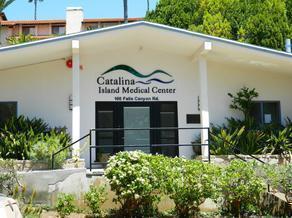As previously reported, Avalon has until 2030 to build a new hospital in order to comply with state earthquake safety standards.
Last week, the Catalina Island Medical Center Foundation—a non-profit that supports the local hospital—submitted signatures to Los Angeles County officials in order to put a $1 tarrif on the April ballot to support the construction of a new hospital.
As previously reported, Avalon has until 2030 to build a new hospital in order to comply with state earthquake safety standards.
Last week, the Catalina Island Medical Center Foundation—a non-profit that supports the local hospital—submitted signatures to Los Angeles County officials in order to put a $1 tarrif on the April ballot to support the construction of a new hospital.
The Catalina Islander recently spoke with Jason Paret, chief executive officer of the Catalina Island Medical Center, about the where the proposed project stands and what the future holds. It has been edited for space.
Catalina Islander: Has a location for the new hospital been selected?
Paret: CIMC is currently in discussions with the Catalina Island Company as well as evaluating other potential properties. With the passage of the ballot measure and the proven support of the community, we are confident that the right piece of property will become available that will meet the needs of our future medical center.
Islander: What’s the status of getting the $60 million bond to fund the new hospital issued? That is the correct figure, right?
Paret: The USDA is very supportive of rural hospitals and has established a financing program for the replacement of aging hospitals.
Once the ballot measure is passed, we will engage the USDA and plan to participate in its low-interest financing program.
Islander: Would the proposed hospital include an emergency room?
Paret: Absolutely. It’s imperative that we improve the current design of the emergency room, which has inadequate space to provide the necessary services to residents and visitors.
A better-designed ER will ensure patient confidentiality and allow us to expand telemedicine services to enable specialists to immediately support ER physicians.
We also hope to install a helipad outside of the ER to expedite essential transfers, which will be extremely beneficial for individuals suffering from a cardiac or stroke episode. Transporting high acuity patients within what is called the “magic hour” will improve their chances for higher quality of life after experiencing crises like heart attacks or strokes.
When we talk about transport, it’s important to counter a misconception that our ER transfers most patients to other facilities.
We track the number of patients we transfer on a monthly basis; we know that the average person who presents at the ER has a 3 percent (to) 5 percent chance of having a condition that warrants the transfer to a specialist on the mainland.
These numbers are not much different than larger hospitals on the mainland.
Islander: Have you heard any concerns from individuals who think a $1 transportation charge might discourage cross channel traffic?
Paret: We have not heard the concern that the transportation fee would reduce visitor traffic to Catalina Island. The largest concern is the increased cost of $1 on each subsidized ticket that residents purchase.
Many rural communities are in the same situation as Catalina Island, with their hospitals not meeting California earthquake standards. They too must be replaced, but the common solution those communities pursue is an increase in property taxes or sales tax. Since both visitors and locals use the hospital in our community, we felt it wasn’t fair for locals to have to carry the full burden of replacing the hospital.
We believe it is best to share the burden among all who use the hospital, including visitors.
If property taxes were to increase, locals would bear 100 percent of the cost of replacing our community’s facility.
With the transportation fee, we estimate visitors will bear over 90 percent of the cost of insuring that high quality healthcare is always available on Catalina.
We are finding that after residents understand the facts on the issues impacting healthcare on Catalina, they are overwhelmingly supportive of the ballot measure.
Islander: If I recall our last conversation correctly, the project would call for the hospital to raise $20 million, have a $60 million bond issue, and use a $1 per person cross channel fee to finance remaining payments on the bond. Correct?
Paret: We have initially projected a cost of $60 million, but this cost will vary and could increase due to inflation.
Construction costs increase each year, and the more time it takes CIMC to begin construction, the higher the cost will be.
We often have community members ask why the cost will be so high. The biggest reason is that the State of California requires healthcare facilities to be constructed at much higher standard than most buildings. In addition, healthcare equipment and materials are much more expensive than an average building.
Hospitals also come with system redundancy requirements that literally save lives.
For example, when electricity, water, or internet are interrupted due to a natural disaster or even maintenance, a hospital must ensure there is redundancy within the system to ensure patients’ health is not adversely impacted.
Islander: What’s the backup plan if the $1 fee cannot be added to the ballot?
Paret: The Catalina Island Medical Center Foundation will pursue a special election as quickly as possible.
The Avalon City Council passed a resolution recently that is in support of a new hospital on Catalina, and expediting the process to ensure the ballot measure is on the April 10, 2018 general election ballot.
Islander: Have any designs for the new hospital been drawn up, or will that have to wait until a location is identified? I recall some concept exterior drawings from the “Final Report” you sent me awhile back, but I gather those could be subject to change.
Paret: The process of designing a hospital has not begun, because to start, we’d need to identify the exact parcel of land. Funds are starting to be raised to pay for the architectural design and permitting process, which will cost between $2 million and $3 million.
We expect that it will take approximately two years to garner community input and begin construction. The architectural design of the exterior is conceptual, and we will be listening to the community prior to a decision being made.
Islander: What’s the potential economic (medical) impact on the Island if the hospital isn’t upgraded?
Paret: Much of this can be estimated. Currently the hospital generates over $15 million dollars in revenue and much of it is reinvested back into the local economy by providing well-paying jobs.
Hospitals are about people serving people, so you won’t be surprised to learn that over 65 percent of the cost associated with operating a hospital is in salaries.
Hospitals in the United States offer some of the best technology in the world to help cure and treat patients. But what makes a hospital great is the personal connection that a group of highly compassionate doctors, nurses, and staff establish with patients even during pain, fear, and crisis.
Islander: Has the hospital begun (or inquired about) the process of getting permits from the required city, county, and state agencies?
Paret: There is no need to begin the permitting process until land is identified, and the architectural process has started. Over the past two years we have been working on creating relationships with Assembly member Patrick O’Donnell; Los Angeles County Supervisor Janice Hahn; and, of course, members of the Avalon City Council. The City Council has been extremely supportive of the hospital, and we could not imagine a better relationship. They truly have the community’s best interest in mind where healthcare is involved.
Islander: What’s the difference between the hospital’s current patient capacity versus the proposed hospital’s capacity?
Paret: About a year ago, an in-depth hospital replacement study was conducted that analyzed the patterns of where patients with the zip code of 90704 go to receive care. It showed that CIMC captures approximately 15 percent of the total healthcare dollars. That means that 85 percent of all healthcare dollars are spent overtown. (Editor’s note: “overtown” is a local term for “on the mainland.”) The CIMC Board of Directors, administration, and staff took a deep look into how we were (and weren’t) serving the needs of our community.
We renewed our effort to sincerely listen to our patients on how they want to receive care. Since that time, revenues have continued to grow as we have made the patient experience as important as the care we provide.
There are many more services that we can provide to residents in our community if we had more space. Mammography, infusion therapy for cancer, expanded physical and occupational therapy, inpatient care, additional visiting specialists, colonoscopies, outpatient orthopedics, and cataract removals are just a few.
There will be additional services that will be provided as we build relationships with more specialists. This will reduce the need for local citizens to travel to the mainland and incur the cost of travel and lost wages due to missing work.
Many people think that the larger the hospital, the higher quality of care a patient must be receiving. Studies have shown that small rural hospitals provide higher quality and a better patient experience than large hospitals. With a new modern facility, CIMC will provide an exceptional healthcare experience that will impress residents and visitors and make them think twice about going anywhere else for care.
If you have a comment or question about the subject of this article, email editor@thecatalinaislander.com.











